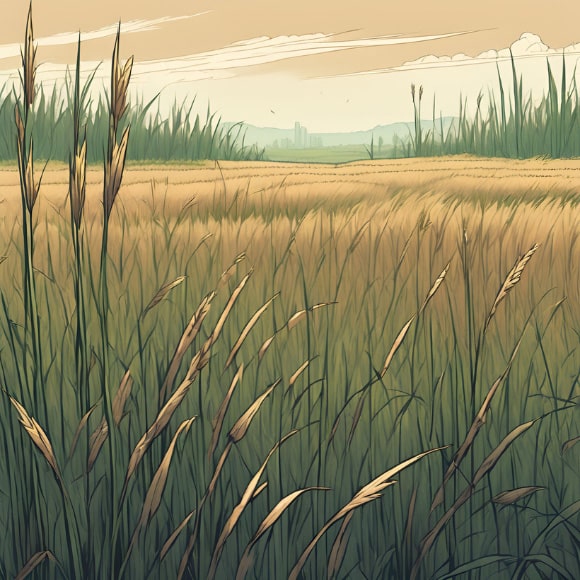Read by Matilda Longbottom

First, a moment of truth: we don’t make hay.
We have a field, and the farmer up the road cuts it, makes hay out of it and takes it home to feed his cows. It’s the easiest thing we grow, since we do … well, absolutely nothing. That hayfield, as far as I’m concerned, is the product of luck and the weather gods. Frankly, I’ve never given much (all right, any) thought to hay.
In the play The Night Thoreau Spent in Jail by Jerome Lawrence and Robert E. Lee, in which Henry is in the clink for refusing to pay taxes to fund the Mexican War, Thoreau challenges readers to see what’s going on in the world around them. “Did you ever have any idea so much was going on in Heywood’s meadow?” In this single pasture, Henry continues, there are three-hundred separate varieties of grass. “There’s camel grass, candy grass, cloud grass, cow-quake, mouse-barley, fox-tail, Londonlace, devil’s knitting needle, feathertop buffalo grass, timothy and barnyard grass and clovers enough to sweeten the bellies of all the lambs since creation.”
As far as I was concerned our field was full of just … grass.
I slouched unhappily into the kitchen and told my husband that I was flunking transcendentalism.
Then I looked up hay.
Hay routinely contains a lot of alfalfa, red and white clover, and timothy grass—none of which, it turns out, are native to America. Prior to the arrival of the Europeans, America was essentially hayless, which likely didn’t matter much, since at the time it was also devoid of hay-eating domestic animals such as horses, cows, sheep, and goats.
Alfalfa—which makes a particularly nutritious and tasty hay—is a legume, like beans and peas. There’s a lot of it in our field; it’s easy to pick out of the crowd because it has lots of little tufty purple flowers. Alfalfa originated somewhere in Asia and, it least according to Pliny the Elder, whose data is often dicey (you can’t help being suspicious of his description of the giant gold-digging ants of Afghanistan) was introduced to Greece in the fifth century BCE by the invading Persians. From there it spread through Europe, and came to North America in the 16th century with the Spaniards, who brought it along to feed their newly imported horses.
Clover, also a legume, is a native of Asia Minor and Europe, and—like asparagus, apples, and dandelions—was brought to America by European colonists. It’s sometimes called trefoil, for its three round leaflets, though occasionally an especially enthusiastic clover will sprout four. Finding one of these is said to be lucky, though nobody knows exactly why—but it’s certainly rare; only one in 10,000 clover plants will have four leaflets. Larger number of leaflets are rarer still: the current champion, according to the Guinness Book of World Records, is a 56-leaf clover discovered in 2009 in Japan.
Of the 300 species of clover, 19 are found in New England—notably red clover and white clover—both of which grow in our field. Red clover (Trifolium pratense) is the state flower of Vermont (by act of the state legislature in 1895). While a minority of state voters favored the mayflower or the buttercup, red clover won by popular landslide, largely because cows eat it. (There was considerably more controversy over the later choice of state bird—the hermit thrush—which, many crossly pointed out, nobody ever saw; also, for at least half the year, it fled the state and relocated south of Pennsylvania.)
Timothy grass—unlike alfalfa and clover—actually is a grass—is sometimes nicknamed meadow cat’s-tail for its fuzzy cattail-like flowerheads. It’s also a European import and seems to have been introduced to New England in the late 1600s. The timothy moniker, according to most sources, comes from farmer Timothy Hanson of Maryland, who developed improved strains of it and promoted it as a high-class hay in the 1720s. Both Thomas Jefferson and Benjamin Franklin talked it up, and Hanson’s hay eventually bounced back across the Atlantic as a prime feed for thoroughbred horses. By the mid-18th century, it was commonly known as timothy grass.
Vermont turns all of the above into a lot of hay.
The season here generally starts in June and extends through the Summer, with a single field churning out multiple batches of hay. In fact, at 366,000 annual tons, Vermont sets the hay record for New England. This may not sound as exciting as some records—say, first place for the largest output of gold, diamonds, or petroleum—but we shouldn’t underestimate hay.
The technologies that have most impacted human life are usually pretty simple. The wheel, for example, packed a substantial punch; so did the nail, the plow, the compass, and the alphabet. Physicist Freeman Dyson. however, argues that a major mover and shaker of civilization was hay.
The invention of hay, Dyson claims, made it possible to keep horses, cows, and oxen alive through the Winter—which in turn paved the way for the growth of major urban centers in chilly northern and western Europe, and eventually in the (frigid) northeast of the New World. Paris, London, Moscow, Boston, and New York, according to Dyson’s theory, were all built on … hay.
Summer is sunshine, the drone of working tractors mowing and raking, the smell of cut grass. And afterwards, the aftermath.
‘Aftermath’ today is a constant in the news, a word used to mean the awful consequences of disaster. There are aftermaths to tornadoes, earthquakes, floods, forest fires, and bombs. But in the hayfield, it’s a more hopeful word.
It comes from the old Anglo-Saxon word maeth, which meant mowing. In the hayfield, an aftermath is a renaissance, a rebirth, a rejuvenation. The aftermath is the second mowing, the crop cut after the grass grows back again. ❖


 Previous
Previous


